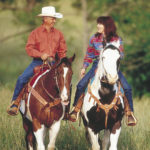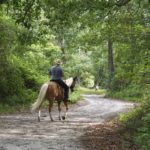Your Vehicle
Take a look at the carriage you plan to drive on the road. Twowheeled carts are fine, as long as your horse is not green or does not have a problem making a tight turn with it, something you will need to do sooner or later. Teaching him to side-pass first will help considerably.
If you are driving a four-wheeled carriage, remember that a carriage with a ?fifth wheel? (a bearing for the undercarriage and front axle assembly attached to the front of the carriage body underside) and ?cut under? design (allowing the front wheels to turn under the carriage body) requires far less room for a turn than something like a surrey or runabout that has a reach, no fifth wheel and is not cut under. The more maneuverable cut under vehicle with a fifth wheel is also less at risk of overturning.
Other considerations: A vehicle tall enough to allow you to look out over the horse’s head is preferable to a sulky in which you ride closer to the road.
Restored antique carriages are a joy to drive as well as to look at. Careful maintenance and inspection will help you feel confident that the vehicle can stand up to frequent use on all types of terrain.
A Word On Brakes
First, avoid the mistaken assumption that the carriage brakes will slow down the horse! If your foot is on the brake and the horse pulls on the traces hard enough, the harness will break and you will soon be alone in the carriage, with no horse. The driving horse needs to learn to keep the carriage from bumping him in the hindquarters by leaning back into properly adjusted breeching. When traveling down a steep grade, use the brake gently to put some slack in the traces, allowing the horse to ?float? in them while supporting him with your hands.
Shoeing
My advice on shoeing is simple. There are studs, drill tech, rubber shoes and borium. The latter gets my vote. In my experience, borium is most effective when used on all four feet, at the toe and heels. The horse needs traction all around to stay balanced. Put on properly, borium should not affect how your horse stands or his way of going. The farrier can use a leather or silicone pad on top of packed Oakum for added comfort on hard surfaces. Before making a final decision, research these options, consult your farrier and ask others who drive regularly on pavement about their experience.
Spares
Carry your spares kit and keep it handy, easily accessible in an emergency? not buried in a cramped storage space in some awkward corner of the carriage. Never venture away from the farm without it, because that will surely be the drive when you need a spares kit the most. The recommended items are:
- wrench to fit axle nuts
- knife (keep it sharp!)
- cooler or quarter sheet
- leather punch (a good, strong one)
- length of rawhide, shoe string or wire
- screwdriver
- rein splice or Sparepare trace
- small hammer
- hame strap (if applicable)
- hoof pick (the kind with a brush on it)
- halter and lead rope
- A ?Leatherman? tool is excellent to have
These are all essential to carry; however, consider adding the following:
- fly spray or clear Swat ointment
- Sting Ease for bee bites
- flashlight and spare batteries
- note pad and pencil
- first-aid kit for you and the horse
- paper towels
- Mace or pepper spray to repel animals
- disposable camera
- collapsible bucket for water
- spare whip
- safety triangles for traffic control
- spare gloves
- rain gear
- Easyboot
- black electrical tape
- plastic zip ties
This is more than you can fit into your spares box, therefore a nice wicker picnic basket attached to the carriage floor works perfectly. You will never be without any of these important items if they are kept on the carriage at all times, and not used for any other purpose.
Tips from farrier Stephen Bright
When are studs better than borium? Studs are usually more useful on turf as opposed to paved road. Gobs of borium may be suitable for horses that spend most of their time on the road (such as Amish buggy horses), but for sport horses that work on a variety of surfaces we generally use less borium, and sometimes none on the toe.
Screw-in studs, by virtue of being removable when conditions change, allow you to change the amount of traction by varying the size of the studs or removing them altogether. Studs are also more uniform than borium; even as a stud ?ages? and its soft metal components wear away, the tungsten carbide tip stays intact. Borium does tend to lose some traction after three or four weeks.
Horses with some age and/or developing soundness problems may be better served with studs than borium, again because traction needs can be tailored.
Shoeing for traction becomes a trade off between gaining grip, and losing ability to slide a little, or roll over at toe smoother.
(Studs do come small enough for smaller feet, like those of my wife Dana?s 12-hand ponies.)





